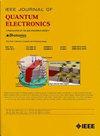热效应对电流调制 DFB-LD 产生的 FMCW 信号性能的影响
IF 2.1
3区 工程技术
Q3 ENGINEERING, ELECTRICAL & ELECTRONIC
引用次数: 0
摘要
在各种商业应用场景中,迫切需要一种经济高效的线性啁啾信号源。基于典型耦合模式理论(CMT)和高效分步时域模型(SS-TDM)方法,数值模拟了热效应对电流调制分布反馈激光二极管(CM-DFB-LD)产生的频率调制连续波(FMCW)信号性能的影响。结果表明,DFB-LD 中的热效应对 FMCW 信号的非线性有显著影响,热效应的增加会导致 FMCW 信号的非线性增强。对于给定的热扩散系数 $D=2.0 \; \times 10^{-5}$ m2/s,随着有源区和衬底之间的厚度 H 从 $1.5 \; \mu $ m 增加到 $6 \; \mu $ m,带宽和非线性度一开始都会逐渐增加,然后趋于饱和。对于 H 固定为 $4.5 \; \mu $ m,随着 D 从 $1.5 \; \times 10^{-5}$ m2/s 增加到 $6 \; \times 10^{-5}$ m2/s,带宽和非线性度都呈现下降趋势。对于 $D = 6.0 \; \times 10.5$ m2/s 和 $H = 4.5 \; \mu $ m,在 19.1 GHz 的带宽下,可以获得非线性度为 3.852 \; \times 10^{-5}$ 和均方根(RMS)为 19.3 MHz 的高质量 FMCW 信号。以这种 FMCW 信号作为传输信号,可以实现 2 米距离的测距,相对误差为 0.340%。本文章由计算机程序翻译,如有差异,请以英文原文为准。
Influences of Thermal Effect on the Performance of FMCW Signal Generated by Current-Modulated DFB-LDs
A cost-effective linear chirp source is urgently needed in various commercial scenarios. Based on typical coupled mode theory (CMT) and a highly effective split-step time-domain model (SS-TDM) method, the influence of thermal effect on the performance of frequency-modulated continuous-wave (FMCW) signal generated by current-modulated distributed feedback laser diodes (CM-DFB-LDs) is numerically simulated. The results show that the thermal effect in DFB-LDs has a significant impact on the nonlinearity of the FMCW signal, and the increasing thermal effect leads to an enhancement in the nonlinearity of the FMCW signal. For a given thermal diffusion coefficient
$D=2.0 \; \times 10^{-5}$
m2/s, with the increase of the thickness H between the active region and the substrate from
$1.5 \; \mu $
m to
$6 \; \mu $
m, both the bandwidth and the nonlinearity increase gradually at first and then tend towards saturation. For H fixed at
$4.5 \; \mu $
m, with the increase of D from
$1.5 \; \times 10^{-5}$
m2/s to
$6 \; \times 10^{-5}$
m2/s, both the bandwidth and the nonlinearity show a downward trend. For
$D = 6.0 \; \times 10.5$
m2/s and
$H = 4.5 \; \mu $
m, a high-quality FMCW signal with a nonlinearity of
$3.852 \; \times 10^{-5}$
and an root mean square (RMS) of 19.3 MHz under a bandwidth of 19.1 GHz can be obtained. Taking such FMCW signal as a transmitted signal, a 2 m distance ranging has been demonstrated, and the relative error is 0.340%.
求助全文
通过发布文献求助,成功后即可免费获取论文全文。
去求助
来源期刊

IEEE Journal of Quantum Electronics
工程技术-工程:电子与电气
CiteScore
4.70
自引率
4.00%
发文量
99
审稿时长
3.0 months
期刊介绍:
The IEEE Journal of Quantum Electronics is dedicated to the publication of manuscripts reporting novel experimental or theoretical results in the broad field of the science and technology of quantum electronics. The Journal comprises original contributions, both regular papers and letters, describing significant advances in the understanding of quantum electronics phenomena or the demonstration of new devices, systems, or applications. Manuscripts reporting new developments in systems and applications must emphasize quantum electronics principles or devices. The scope of JQE encompasses the generation, propagation, detection, and application of coherent electromagnetic radiation having wavelengths below one millimeter (i.e., in the submillimeter, infrared, visible, ultraviolet, etc., regions). Whether the focus of a manuscript is a quantum-electronic device or phenomenon, the critical factor in the editorial review of a manuscript is the potential impact of the results presented on continuing research in the field or on advancing the technological base of quantum electronics.
 求助内容:
求助内容: 应助结果提醒方式:
应助结果提醒方式:


